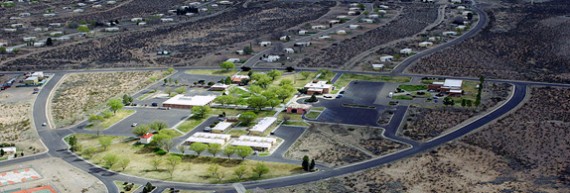When the Road Home is Blocked
“I don’t have a hometown.” Brian Stanford clenches his glass of iced tea when he declares this.
We are sitting in my parents’ dining room. My nephew’s high school graduation party is winding down, and the sun is setting on the Gila wilderness. Being twenty miles outside of Silver City means there are no hazy street lights to dilute the colors. No traffic booming over the tweet and titter of nightfall.
Brian is an imposing figure—barrel chest, leather skin, and hazel eyes about as frank as a whip crack. I can tell that rather than be interviewed, he would prefer to be outside sipping tea and watching the sunset.
But, just like when we were kids, he makes an exception for his little cousin. For all I know, he still fears my prolific tattle-telling.
“Someone can ask me: where’d you grow up? Playas. Well, can I go see it? No—I don’t have a hometown anymore.” Brian drains the rest of the tea and ice clatters to the bottom of the glass.
Neither of us has a hometown anymore. Yet unlike towns and municipalities wiped out by forest fires or obliterated by hurricanes, Playas still exists. All the homes, buildings, streets, and trees are still standing. In fact, they are only about eighty miles from where we’re sitting. Less than two hours’ drive and we could arrive in the boot heel of New Mexico. But we can’t just get in a car and go there.
All civilian access to Playas was blocked off nearly eight years ago. Armed guards stationed at a roadside booth just outside of town stop all traffic, coming or going. Only authorized residents, authorized guests, and authorized personnel are allowed.
In the mid-2000s, Playas transformed from a cluster of sun-baked bungalows to the Playas Research and Training Center (PRTC), a hot commodity for homeland security. The PRTC plays host to the nation’s premier anti-insurgency, anti-terror, and emergency preparedness training facility. (And you thought it was all creosote and coyotes.) Law enforcement officers, emergency responders, and soldiers carry out realistic simulations.
There, they contain epidemic outbreaks. Rescue hostages. Search homes for suspected terrorist cells. Batter down doors and send K-9 units after suspects. Blow up buildings. Crash helicopters. Gossip with Afghani tribal elders. It’s like Rambo’s version of a Universal Studios in the Southwest.
When training is needed, a PRTC contractor, Command Post Technologies (CPT), stocks the otherwise empty town site with anything and everything that is needed to evoke reality during training: role players from Afghanistan, goats, chickens, donkeys; anything.
(With headquarters in Suffolk, Virginia, CPT is a “service disabled veteran owned small business.” SDVOSBs are entrepreneurships with special consideration for prime government contracts and subcontracts.)
Similar simulation facilities exist elsewhere in the U.S. There’s Disaster City, Texas — masterminded by Texas A&M to provide grand-scale disaster training complete with collapsible high rises. Just outside Joshua Tree National Park in California, there’s the constructed Iraqi village of Wadi al-Saraha. Marines going on a tour of Iraq were first sent to Wadi al-Saraha for military and culture training. Then there’s Fort Irwin’s National Training Center in the Mojave Desert, complete with several mock-villages used to train troops on urban warfare in the Middle East. And on the list goes.
But Playas is unlike any of these simulation centers because it was not constructed for training simulations. It was built for real people—real families. Roughly 1,000 residents called Playas home.
The Phelps Dodge Corporation (PD) erected Playas in the early 1970s to house its employees. As the largest copper miner in the U.S., PD trucked copper mined in Bisbee, Arizona, to Playas. There, the copper was smelted into 800 pound copper anodes. (To picture an anode, just imagine a rectangle curling up its arms to show off its muscular mineral biceps.) The copper anodes wound up in El Paso, Texas, for a bit more processing before becoming wiring in cars, houses, and electronics.
Unfortunately, all that smelting meant belching toxic chemicals into the air, so the town and the smelting plant were put out in the middle of the desert, nearly 100 miles from any real civilization.
My dad, Anthony Mason, woke up religiously at four a.m. to carpool out to the smelter where he drove massive cranes that ladled bright molten rock into vats. My mom, Donna, worked just about everywhere in town. She was a nurse at the clinic, a cook at the bowling alley, and even clerked at the little grocery store for a time.
Except in summers when we could prowl the desert freely, we kids were out the door every morning at six to catch the bus to the public school some twenty miles away in the ranching community of Animas. “Ranching community” sounds almost too sophisticated. Animas is more of a wide spot on the road. A bakery, burger joint, post office, feed store, and some houses pepper the intersection of two state highways. Mixed in are all the facilities of the Animas Public Schools: elementary, middle, and high school occupy the same patch of real estate. They also share a cafeteria/auditorium. Oh, and the football field.
One cannot speak of Animas without mentioning the hallowed grounds of the football field. From 1986 to 1990, the mighty Panther football team held the national record for longest winning streak (69 consecutive wins). Brian played on that team during the glory days. He and his teammates made all 300 or so K-12 Animas students a proud feral pack.
When school let out, we bussed back to Playas, a desert playground complete with a 6-lane bowling alley, rodeo ring, racetrack, and a public swimming pool. In town, there was always something going on: tennis tournaments, basketball round-robins, baseball games, picnics at the parks, magical Christmas bazaars, and spectacular Fourth of July celebrations. Add to that the school plays, band concerts, volleyball and track competitions, and—of course—Friday Night Football Games.
It was small-town life at its best…and its worst.
The nearest metropolis, Las Cruces, was more than three hours away. Albuquerque and Santa Fe were far enough to seem fictional. Ours was a world of star-splashed night skies and vast desert plains with quivering mirages pushing the horizon out of reach. We craved the world, never realizing that it would soon descend on our dear town and ruin it.
In the greater world of stock markets and commodities, copper prices declined. In June of 1999—less than a month after I graduated from high school—PD announced that the smelter was shutting down. The news was devastating. Local and national newspapers computed the losses to the region in the double-digit millions of dollars. Residents computed it differently. Everyone was evicted from their rented bungalow.
Roxanne Gonzales, 33, a friend and classmate of mine, still remembers the moment when her dad called home to share the news of the shutdown. “He had so much excitement in his voice because this was finally his ticket out of Playas!” she recounts. Later, she found out that the excitement was actually shock. Like anyone caught in the maelstrom, the Gonzales family reeled at the thought of leaving Playas. Where would they go? Where would they find work?
By September, the smelter shut its doors and 450 of the 500 employees were out of work. A skeleton crew of 13 employees was retained to detoxify the last stockpiles of smelting by-products. Others were kept on to work at the grocery store, the bowling alley, or to do basic maintenance around town.
Brian’s dad, David Stanford, was one of the lucky few asked to stay on. It seemed appropriate given David’s legacy at PD. His father, J. J. “Bud” Stanford, had mined the mineral-rich mountains in Bisbee after serving in the second World War. David got his start with PD in 1969, working as a mechanic’s helper in Bisbee’s Lavender Pit. (A mining pit, if you have never seen one, is a city-wide, skyscraper-deep hole scraped out of the ground.) He was transferred to Playas in 1975 and stayed there. By 1981 he had worked his way out of other pit-equivalent jobs to become the Power Plant General Foreman. In other words, David was now “big brass.”
For two weeks after news of the shutdown, David and his family lingered in a state of panic, shock, and anger as they waited for his layoff to become official. But then, David was told he would be kept on to manage the standby systems out at the smelter.
“I had my retirement job,” David writes in an email. (The damage from too many years working on or around screaming metal machinery prevents us from doing a phone interview.) Because he had been in Playas from the town’s beginning, he knew how to operate everything. The transition felt ideal, even apt.
But David and his family bore witness to the community’s slow demise. Every day, a moving truck filled up, another house emptied, and another family drove toward that unreachable horizon. Every night, the town grew a little darker, the streets a little quieter.
“I got to live through the Wild Wild West in the new era,” Brian recalls of the empty town surrounded by an expanse of empty desert. To him, the experience felt lawless and deliciously free.
David’s retirement job turned into cutting the remaining staff in half every year. In 2000, he had to gut the staff from 50 to 24. One month after the attacks on the World Trade Center, David was asked to chop the staff down to 12.
“I struggled putting that list together,” he admits. Fortunately, the “big boss” from Silver City said he would come down and deliver the bad news to the crew on David’s behalf. “Well, he showed up,” David recalls, “and after about 30 minutes, the secretary called me and said the big guy needed to see me. When I showed up, he slid a manila envelope across the table, and when I opened it, there was my retirement papers.” Rather than cut the staff in half, the company retired three employees with higher salaries.
“Made it easier to keep people that cost less on the payroll. And they could get some real work out of [those guys] instead of us old timers! (Ha!)” David writes.
Shortly after retiring, David and his family said their goodbyes to friends and to the town. Within a few years of their departure, the security booth went up and the town was blocked off from the general public.
Playas was about to enter a whole new phase.




Responses to “A Community Commoditized: Playas, New Mexico Pt. 1”